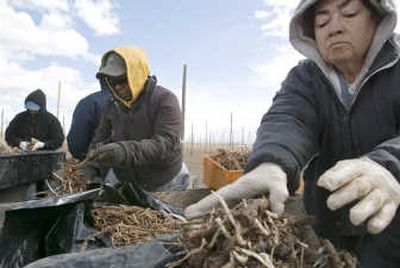Hop growers expand

YAKIMA – Few people can remember a situation anything close to this.
Some Yakima Valley hop growers are pulling other crops to plant the beer-flavoring ingredient and planting new acreage in response to a worldwide shortage that caught everyone – brewers, dealers and growers – by surprise.
A decade of oversupply and low prices that sent acreage plummeting by more than a third is over, at least for now.
In response to that limited supply, by the end of last year some prices jumped to 10 times historic levels, $20 per pound and more on the “spot” market. “Spot” hops are those not committed under long-term contracts.
That’s where the industry stands this spring in Washington, the nation’s largest supplier of hops, and the two other Northwest states that comprise all national production.
Washington, Oregon and Idaho grew hops on 30,911 acres last year, according to industry figures.
Growers are feverishly reconditioning yards and adding new land at an unheard-of pace. Growers are receiving multiple-year contracts with prices front-loaded to help them shoulder the estimated $6,000-per-acre cost to plant yards and also upgrade equipment.
Growers couldn’t make investments like that when prices were depressed.
“It’s basic economics,” observed Ann George, administrator of the Moxee-based Washington Hop Commission. “When everyone started making orders, we found we had a shortage. The price went crazy. People are willing to spend large sums.”
Northwest hop acreage, which expanded by about 2,000 acres last year as the lack of supply became apparent, could grow by another 5,000 acres this year.
Ralph Olson, general manager of grower-owned HopUnion of Yakima, a buyer who deals primarily with smaller craft brewers, thinks the figure may be closer to 8,000 acres by the time all is said and done. That would be a jump of nearly 25 percent in acreage in one year.
“The expansion is being driven by demand,” Olson said. “Part of it stems from this being an international market. You have a lot of Eastern Europeans who have the euro, a strong currency now. They are short and have a huge demand for hops from anywhere. They will pay whatever.
“It’s brought the whole market up,” he added.
George said most observers believe the higher prices are temporary until supply again catches up with demand.
“All estimates are this will be a short-term run-up. The big challenge is to pinpoint what acreage is necessary to supply demand without overshooting demand,” George said.
For the time being, growers are responding.
Longtime Toppenish grower Joe Champoux pulled out 30 acres of producing Granny Smith apples to plant hops last fall. He said he has heard growers also withdrew Concord grapes to plant hops.
He will harvest 330 acres of hops this year.
The past few years have been tough ones for the industry. Average prices dipped to $1.60 in 1997 and rebounded only slightly, according to industry figures.
Despite the end-of-the-year price jump for a small amount of uncontracted hops, average prices for 2007 were $2.75 per pound in Washington.
“Prices have been below the cost of production,” Champoux said. “We have been working on efficiencies and margins for so many years. It didn’t allow for expanding equipment. Now we are able to do some things.”
The oversupply began a decade ago with a switch to different varieties of hops that produced more alpha acid, the ingredient that gives beer its distinctive flavor.
These super alpha varieties produce up to 18 percent alpha acid, compared with up to 15 percent for high alpha varieties. Another group of varieties, aroma, average up to 8 percent alpha.
Meanwhile, other hop-producing countries were planting their own super alpha hops. The result was a market that had more hops than it could use. Plus, processed hops have a long shelf life that made it even more difficult to work off the surplus, George said.
The Northwest produces as many as 30 varieties of hops.
As acreage declined, weather problems and below-average yields brought an end to the oversupply.
“When we got to the 2007 harvest, the yields for a number of individual varieties were at or below average and some growers couldn’t fill their contracts,” George said. “There were not a lot of spot hops around, which is what drove the price up.”
Growers who had been holding uncontracted hops from prior years were able to move them last winter at good prices.
Rapid growth in the craft brewing industry also contributed to an increase in demand for hops. Craft brewers are growing in numbers and now account for about 10 percent of the overall crop.
David Mickelson, president of Redhook Ale Brewery, said the Woodinville-based brewery had difficulty obtaining sufficient supplies of hops last year. This is despite Redhook, with a production of about 315,000 barrels a year, being the state’s largest brewer and committed to advance contracting to assure availability of hops.
“We had to really search around more so than ever before,” Mickelson said.
While others have been able to get what they need with ease on the spot market, brewers are now having to think in terms of locking up supplies with more long-term contracting.
Champoux, who has been growing hops for 30 years, said growers are now seeing a chance to upgrade and build up some reserves from the down years.
George wonders how long the current situation will last. “The big challenge is finding the perfect balance. How do we hit that and keep the brewers happy and not go into oversupply?” she said.